technical data DODGE SPRINTER 2007 2.G Owner's Manual
[x] Cancel search | Manufacturer: DODGE, Model Year: 2007, Model line: SPRINTER, Model: DODGE SPRINTER 2007 2.GPages: 393, PDF Size: 7.61 MB
Page 362 of 393
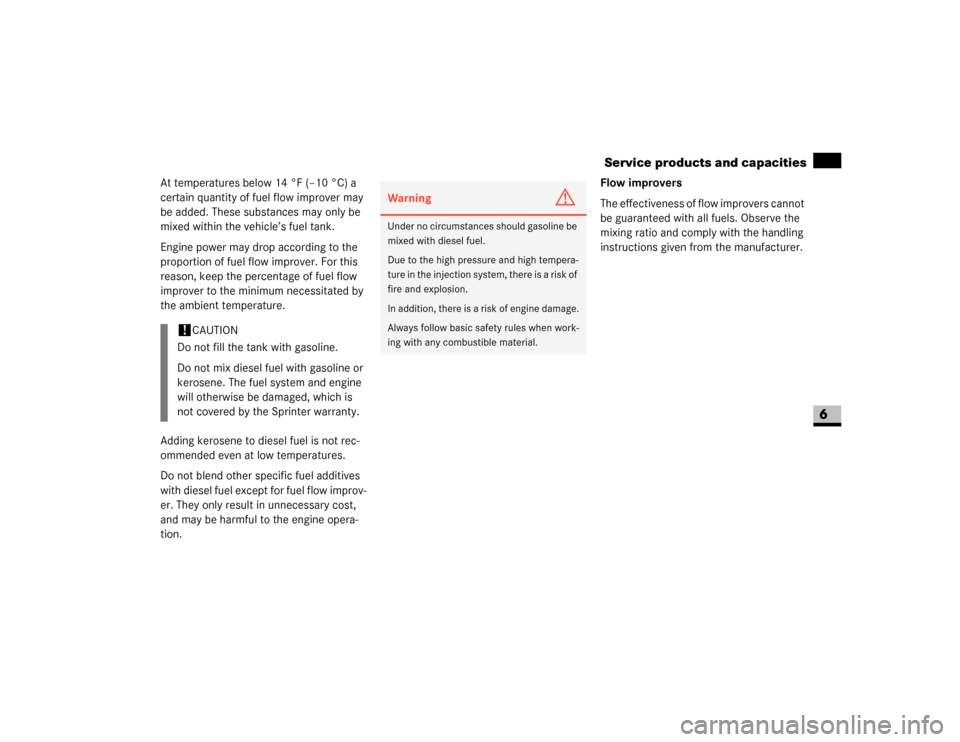
361 *Technical data
Service products and capacities
6
At temperatures below 14 °F (–10 °C) a
certain quantity of fuel flow improver may
be added. These substances may only be
mixed within the vehicle’s fuel tank.
Engine power may drop according to the
proportion of fuel flow improver. For this
reason, keep the percentage of fuel flow
improver to the minimum necessitated by
the ambient temperature.
Adding kerosene to diesel fuel is not rec-
ommended even at low temperatures.
Do not blend other specific fuel additives
with diesel fuel except for fuel flow improv-
er. They only result in unnecessary cost,
and may be harmful to the engine opera-
tion.Flow improvers
The effectiveness of flow improvers cannot
be guaranteed with all fuels. Observe the
mixing ratio and comply with the handling
instructions given from the manufacturer.
!
CAUTION
Do not fill the tank with gasoline.
Do not mix diesel fuel with gasoline or
kerosene. The fuel system and engine
will otherwise be damaged, which is
not covered by the Sprinter warranty.
Warning
G
Under no circumstances should gasoline be
mixed with diesel fuel.
Due to the high pressure and high tempera-
ture in the injection system, there is a risk of
fire and explosion.
In addition, there is a risk of engine damage.
Always follow basic safety rules when work-
ing with any combustible material.
Page 363 of 393
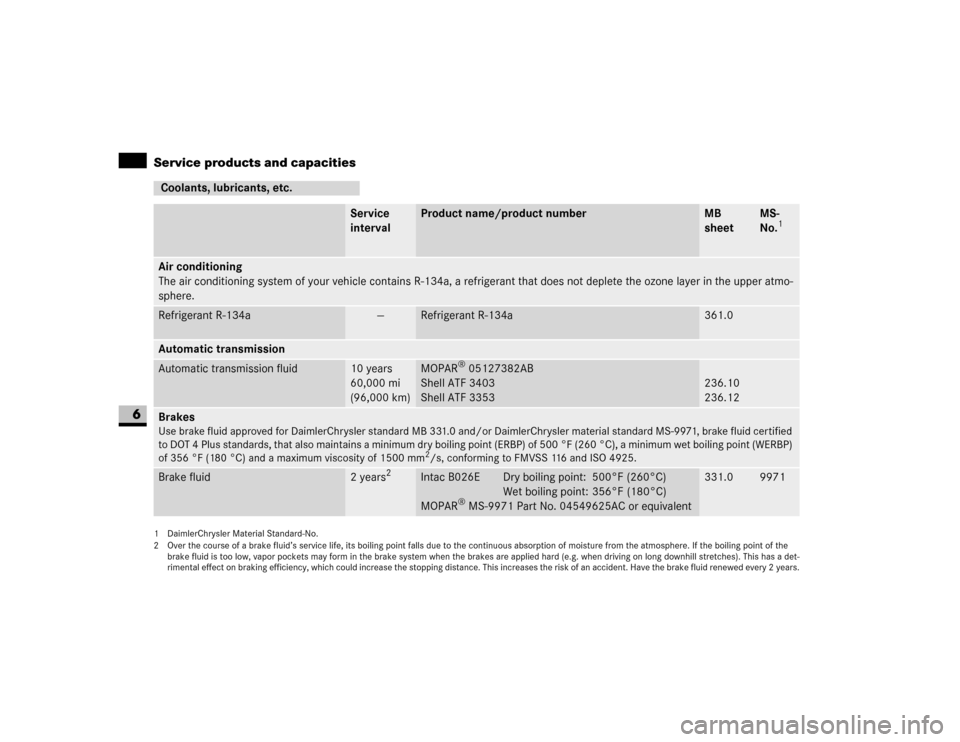
362 *Technical dataService products and capacities
6
Coolants, lubricants, etc.
Service
interval
Product name/product number
MB
sheet
MS-
No.
1
Air conditioning
The air conditioning system of your vehicle contains R-134a, a refrigerant that does not deplete the ozone layer in the upper atmo-
sphere.Refrigerant R-134a
—
Refrigerant R-134a
361.0
Automatic transmissionAutomatic transmission fluid
10 years
60,000 mi
(96,000 km)
MOPAR
® 05127382AB
Shell ATF 3403
Shell ATF 3353
236.10
236.12
BrakesUse brake fluid approved for DaimlerChrysler standard MB 331.0 and/or DaimlerChrysler material standard MS-9971, brake fluid certified
to DOT 4 Plus standards, that also maintains a minimum dry boiling point (ERBP) of 500 °F (260°C), a minimum wet boiling point (WERBP)
of 356 °F (180 °C) and a maximum viscosity of 1500 mm
2/s, conforming to FMVSS 116 and ISO 4925.
Brake fluid
2 years
2
Intac B026E Dry boiling point: 500°F (260°C)
Wet boiling point: 356°F (180°C)
MOPAR
® MS-9971 Part No. 04549625AC or equivalent
331.0
9971
1 DaimlerChrysler Material Standard-No.
2 Over the course of a brake fluid’s service life, its boiling point falls due to the continuous absorption of moisture from the atmosphere. If the boiling point of the
brake fluid is too low, vapor pockets may form in the brake system when the brakes are applied hard (e.g. when driving on long downhill stretches). This has a det-
rimental effect on braking efficiency, which could increase the stopping distance. This increases the risk of an accident. Have the brake fluid renewed every 2 years.
Page 364 of 393
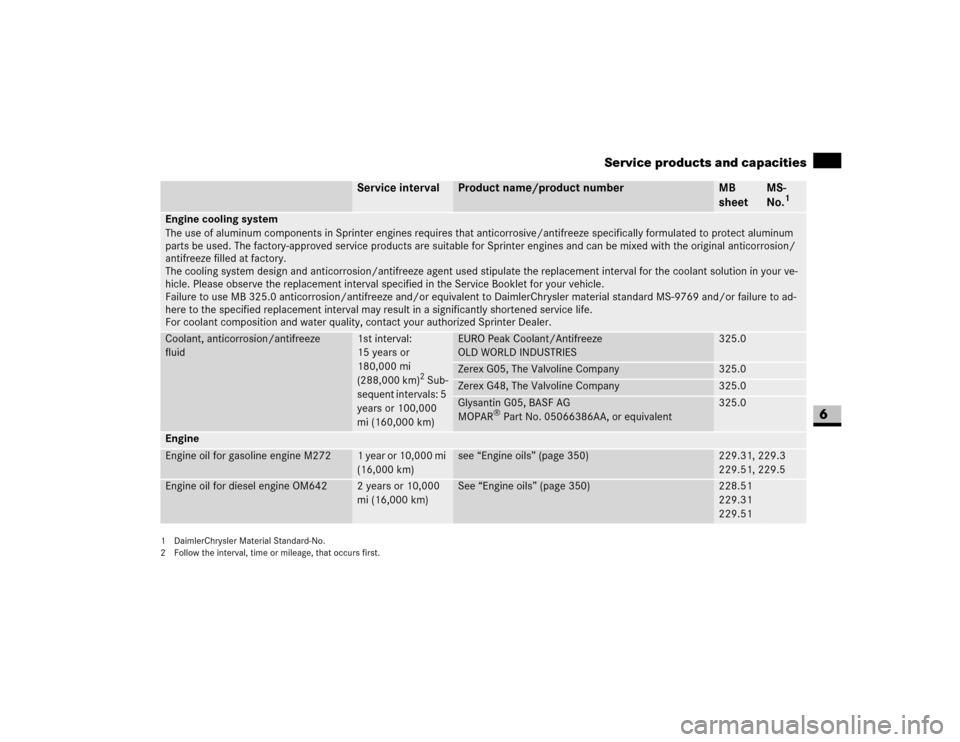
363 *Technical data
Service products and capacities
6
Service interval
Product name/product number
MB
sheet
MS-
No.
1
Engine cooling system
The use of aluminum components in Sprinter engines requires that anticorrosive/antifreeze specifically formulated to protect aluminum
parts be used. The factory-approved service products are suitable for Sprinter engines and can be mixed with the original anticorrosion/
antifreeze filled at factory.
The cooling system design and anticorrosion/antifreeze agent used stipulate the replacement interval for the coolant solution in your ve-
hicle. Please observe the replacement interval specified in the Service Booklet for your vehicle.
Failure to use MB 325.0 anticorrosion/antifreeze and/or equivalent to DaimlerChrysler material standard MS-9769 and/or failure to ad-
here to the specified replacement interval may result in a significantly shortened service life.
For coolant composition and water quality, contact your authorized Sprinter Dealer.Coolant, anticorrosion/antifreeze
fluid
1st interval:
15 years or
180,000 mi
(288,000 km)
2 Sub-
sequent intervals: 5
years or 100,000
mi (160,000 km)
EURO Peak Coolant/Antifreeze
OLD WORLD INDUSTRIES
325.0
Zerex G05, The Valvoline Company
325.0
Zerex G48, The Valvoline Company
325.0
Glysantin G05, BASF AG
MOPAR
® Part No. 05066386AA, or equivalent
325.0
EngineEngine oil for gasoline engine M272
1 year or 10,000 mi
(16,000 km)
see “Engine oils” (page 350)
229.31, 229.3
229.51, 229.5
Engine oil for diesel engine OM642
2 years or 10,000
mi (16,000 km)
See “Engine oils” (page 350)
228.51
229.31
229.51
1 DaimlerChrysler Material Standard-No.
2 Follow the interval, time or mileage, that occurs first.
Page 365 of 393
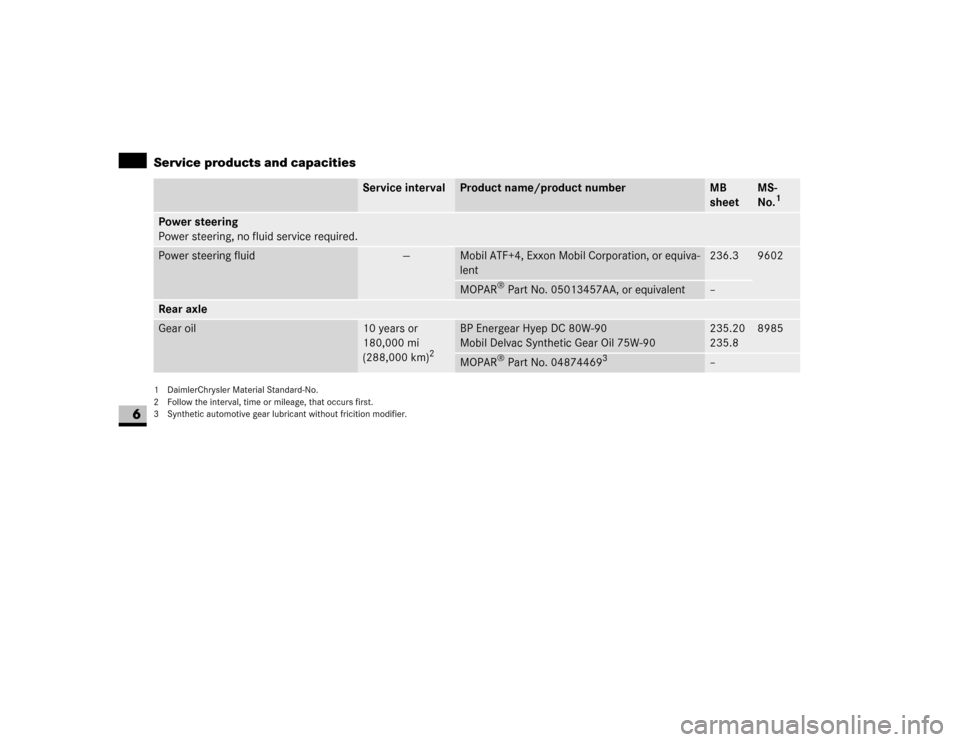
364 *Technical dataService products and capacities
6
Service interval
Product name/product number
MB
sheet
MS-
No.
1
Power steering
Power steering, no fluid service required.Power steering fluid
—
Mobil ATF+4, Exxon Mobil Corporation, or equiva-
lent
236.3
9602
MOPAR
® Part No. 05013457AA, or equivalent
–
Rear axleGear oil
10 years or
180,000 mi
(288,000 km)
2
BP Energear Hyep DC 80W-90
Mobil Delvac Synthetic Gear Oil 75W-90
235.20
235.8
8985
MOPAR
® Part No. 04874469
3
–
1 DaimlerChrysler Material Standard-No.
2 Follow the interval, time or mileage, that occurs first.
3 Synthetic automotive gear lubricant without fricition modifier.
Page 366 of 393
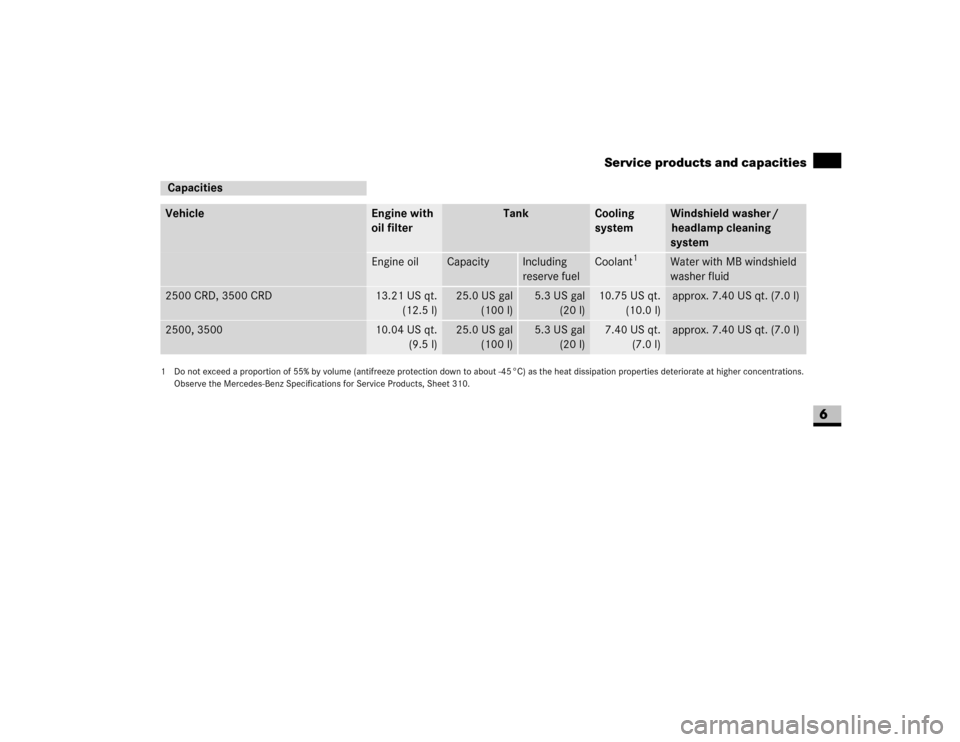
365 *Technical data
Service products and capacities
6
CapacitiesVehicle
Engine with
oil filter
Tank
Cooling
system
Windshield washer /
headlamp cleaning
system
Engine oil
Capacity
Including
reserve fuel
Coolant
1
1 Do not exceed a proportion of 55% by volume (antifreeze protection down to about -45 °C) as the heat dissipation properties deteriorate at higher concentrations.
Observe the Mercedes-Benz Specifications for Service Products, Sheet 310.
Water with MB windshield
washer fluid
2500 CRD, 3500 CRD
13.21 US qt.
(12.5 l)
25.0 US gal
(100 l)
5.3 US gal
(20 l)
10.75 US qt.
(10.0 l)
approx. 7.40 US qt. (7.0 l)
2500, 3500
10.04 US qt.
(9.5 l)
25.0 US gal
(100 l)
5.3 US gal
(20 l)
7.40 US qt.
(7.0 l)
approx. 7.40 US qt. (7.0 l)
Page 367 of 393
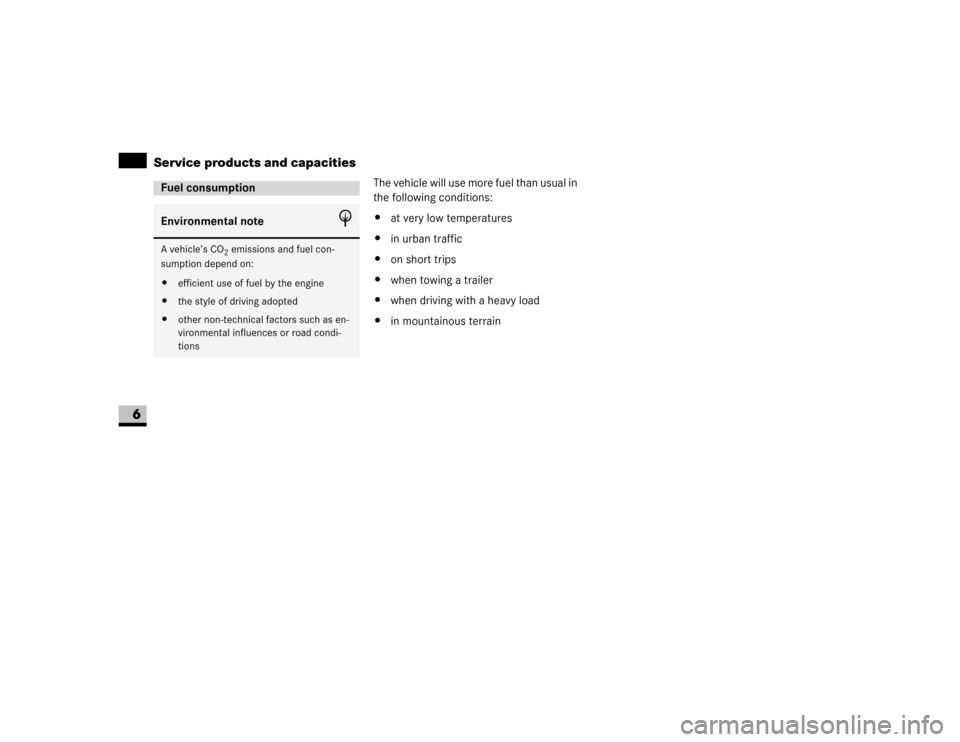
366 *Technical dataService products and capacities
6
The vehicle will use more fuel than usual in
the following conditions:
\4at very low temperatures
\4in urban traffic
\4on short trips
\4when towing a trailer
\4when driving with a heavy load
\4in mountainous terrain
Fuel consumptionEnvironmental note
H
A vehicle’s CO
2 emissions and fuel con-
sumption depend on:
\4efficient use of fuel by the engine
\4the style of driving adopted
\4other non-technical factors such as en-
vironmental influences or road condi-
tions
Page 368 of 393
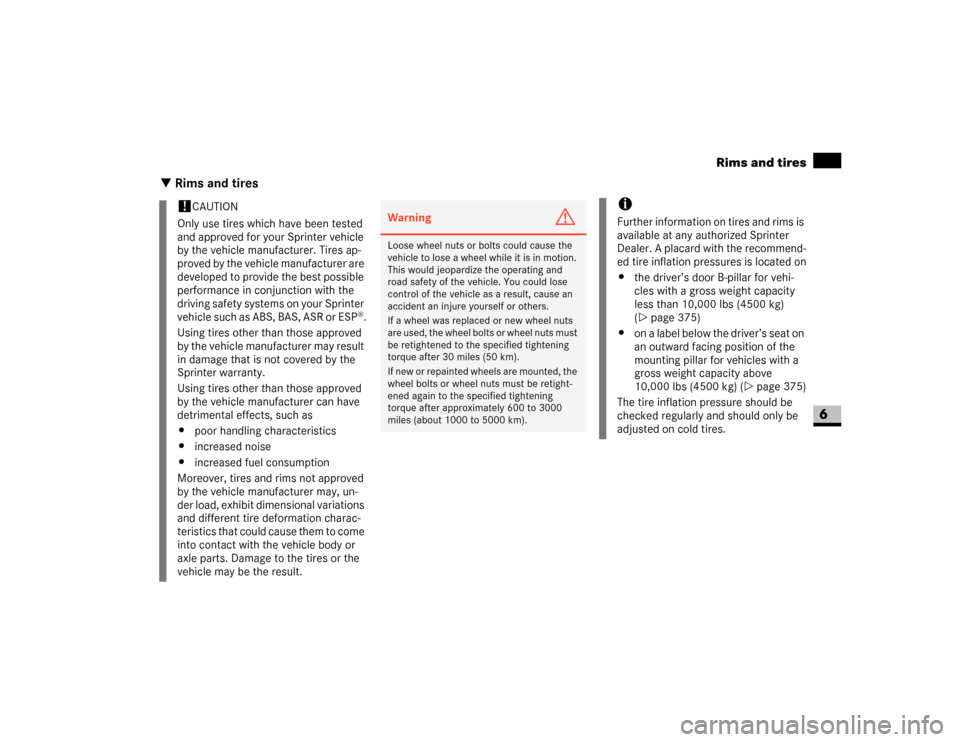
367 *Technical data
Rims and tires
6
\3 Rims and tires
!
CAUTION
Only use tires which have been tested
and approved for your Sprinter vehicle
by the vehicle manufacturer. Tires ap-
proved by the vehicle manufacturer are
developed to provide the best possible
performance in conjunction with the
driving safety systems on your Sprinter
vehicle such as ABS, BAS, ASR or ESP
®.
Using tires other than those approved
by the vehicle manufacturer may result
in damage that is not covered by the
Sprinter warranty.
Using tires other than those approved
by the vehicle manufacturer can have
detrimental effects, such as
\4poor handling characteristics
\4increased noise
\4increased fuel consumption
Moreover, tires and rims not approved
by the vehicle manufacturer may, un-
der load, exhibit dimensional variations
and different tire deformation charac-
teristics that could cause them to come
into contact with the vehicle body or
axle parts. Damage to the tires or the
vehicle may be the result.
Warning
G
Loose wheel nuts or bolts could cause the
vehicle to lose a wheel while it is in motion.
This would jeopardize the operating and
road safety of the vehicle. You could lose
control of the vehicle as a result, cause an
accident an injure yourself or others.
If a wheel was replaced or new wheel nuts
are used, the wheel bolts or wheel nuts must
be retightened to the specified tightening
torque after 30 miles (50 km).
If new or repainted wheels are mounted, the
wheel bolts or wheel nuts must be retight-
ened again to the specified tightening
torque after approximately 600 to 3000
miles (about 1000 to 5000 km).
iFurther information on tires and rims is
available at any authorized Sprinter
Dealer. A placard with the recommend-
ed tire inflation pressures is located on
\4the driver’s door B-pillar for vehi-
cles with a gross weight capacity
less than 10,000 lbs (4500 kg)
(\2page 375)
\4on a label below the driver’s seat on
an outward facing position of the
mounting pillar for vehicles with a
gross weight capacity above
10,000 lbs (4500 kg) (\2page 375)
The tire inflation pressure should be
checked regularly and should only be
adjusted on cold tires.
Page 369 of 393
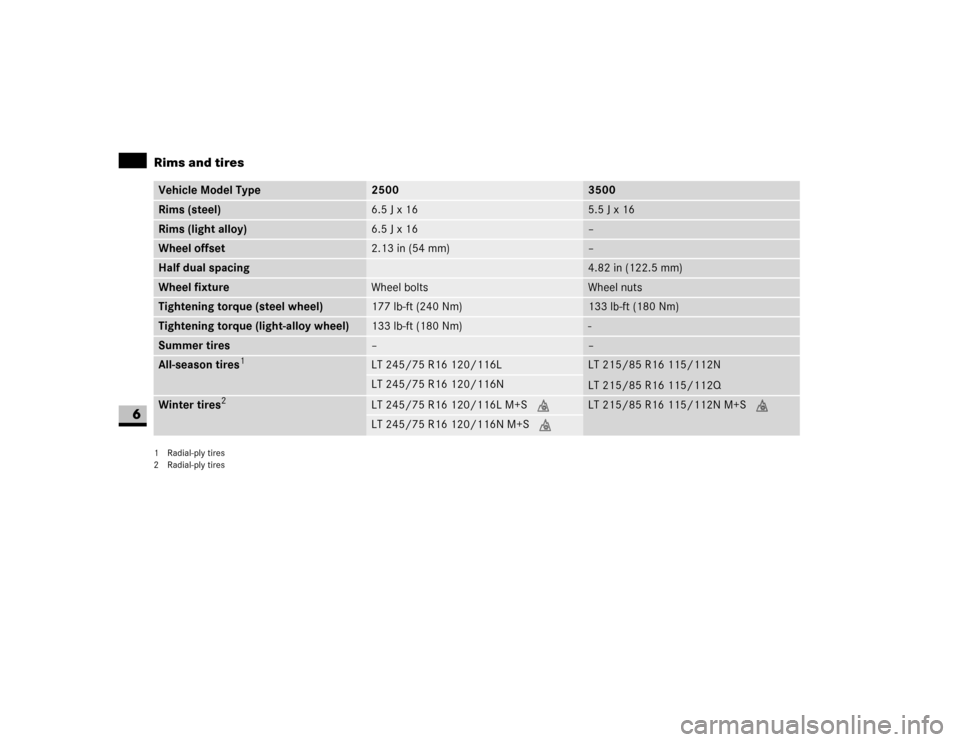
368 *Technical dataRims and tires
6
Vehicle Model Type
2500
3500
Rims (steel)
6.5 J x 16
5.5 J x 16
Rims (light alloy)
6.5 J x 16
–
Wheel offset
2.13 in (54 mm)
–
Half dual spacing
4.82 in (122.5 mm)
Wheel fixture
Wheel bolts
Wheel nuts
Tightening torque (steel wheel)
177 lb-ft (240 Nm)
133 lb-ft (180 Nm)
Tightening torque (light-alloy wheel)
133 lb-ft (180 Nm)
-
Summer tires
–
–
All-season tires
1
1 Radial-ply tires
LT 245/75 R16 120/116L
LT 215/85 R16 115/112N
LT 215/85 R16 115/112Q
LT 245/75 R16 120/116N
Winter tires
2
2 Radial-ply tires
LT 245/75 R16 120/116L M+S .
LT 215/85 R16 115/112N M+S .
LT 245/75 R16 120/116N M+S .
Page 370 of 393

369 *Technical data
Tire inflation pressure
6
\3 Tire inflation pressureFor vehicles with a gross weight capacity
above 10,000 lbs (4500 kg) only.
For vehicles with a gross weight capacity
less than 10,000 lbs (4500 kg) observe the
recommended cold tire inflation pressures
listed on the tire and loading information
placard on the driver’s door B-pillar
(\2page 210).
Observe the information on recommended
tyre inflation pressure in the “Operation”
section (\2page 210).
The following table lists the recommended
cold tire inflation pressures for all load
conditions up to the maximum permissible
weight limits (GAWR). The tire inflation
pressures listed apply to the tires installed
as original equipment.
Set the correct tyre pressure before load-
ing the vehicle. If the vehicle has been
loaded, check the tyre pressures and cor-
rect them if necessary.The tires can be considered cold if the ve-
hicle has been parked for at least 3 hours
or driven less than 1 mile (1.6 km) at an
ambient temperature of approximately
68 °F (20 °C).
Keeping the tires properly inflated pro-
vides the best handling, tread life and
riding comfort.
Tire temperature and tire inflation pressure
are also increased while driving, depending
on the driving speed and the tire load.
Tire inflation pressure changes by approxi-
mately 1.5 psi (0.1 bar) per 18 °F (10 °C)
of air temperature change. Keep this in
mind when checking tire inflation pressure
where the temperature is different from
the outside temperature.
iIn addition to the following table the
recommended cold tire inflation pres-
sures are listed on a label below the
driver’s seat on an outward facing posi-
tion of the mounting pillar.
Warning
G
Follow recommended tire inflation pres-
sures.
Do not underinflate tires. Underinflated tires
wear excessively and/or unevenly, adverse-
ly affect handling and fuel economy, and are
more likely to fail from being overheated.
Do not overinflate tires. Overinflated tires
can adversely affect handling and ride com-
fort, wear unevenly, increase stopping dis-
tance, and result in sudden deflation
(blowout) because they are more likely to
become punctured or damaged by road de-
bris, potholes etc.
Page 371 of 393
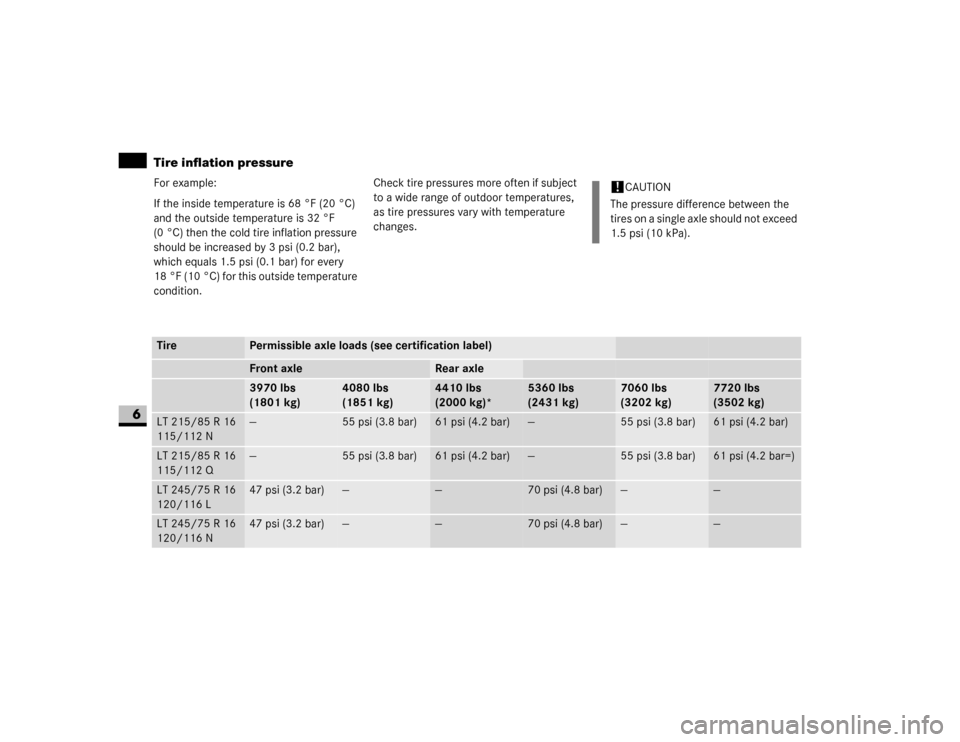
370 *Technical dataTire inflation pressure
6
For example:
If the inside temperature is 68 °F (20 °C)
and the outside temperature is 32 °F
(0 °C) then the cold tire inflation pressure
should be increased by 3 psi (0.2 bar),
which equals 1.5 psi (0.1 bar) for every
18 °F (10 °C) for this outside temperature
condition.Check tire pressures more often if subject
to a wide range of outdoor temperatures,
as tire pressures vary with temperature
changes.
!
CAUTION
The pressure difference between the
tires on a single axle should not exceed
1.5psi (10kPa).
Tire
Permissible axle loads (see certification label)Front axle
Rear axle
3970 lbs
(1801 kg)
4080 lbs
(1851 kg)
4410 lbs
(2000 kg)*
5360 lbs
(2431 kg)
7060 lbs
(3202 kg)
7720 lbs
(3502 kg)
LT 215/85 R 16
115/112 N
—
55 psi (3.8 bar)
61 psi (4.2 bar)
—
55 psi (3.8 bar)
61 psi (4.2 bar)
LT 215/85 R 16
115/112 Q
—
55 psi (3.8 bar)
61 psi (4.2 bar)
—
55 psi (3.8 bar)
61 psi (4.2 bar=)
LT 245/75 R 16
120/116 L
47 psi (3.2 bar)
—
—
70 psi (4.8 bar)
—
—
LT 245/75 R 16
120/116 N
47 psi (3.2 bar)
—
—
70 psi (4.8 bar)
—
—